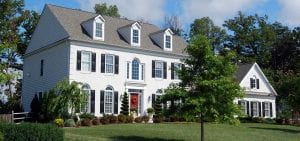A professional home inspection is designed to help uncover unknown potential problems or things to be aware of about the home you wish to purchase. If you are a first time or experienced homebuyer, this home inspection checklist can be used as a general overview when making a decision on whether to purchase the home or not. It should not, however, be used in place of a home inspection with a licensed professional. It may be used in combination with a home inspection to assist you in creating a to-do list and prioritizing what you want to get done or addressed.

This home inspection checklist will help you make an informed decision regarding the home you are looking to purchase. We recommend going over each part of the home one at a time, ticking off things on the list when you find them to be in excellent working order. You can also make notes on concerns or questions you may have for your home inspector.
Exterior Envelope Home Inspection Checklist
The major goal of the exterior envelope is to keep water out of the walls and other inside spaces. When examining these regions, consider the long term and see if they will preserve the interior in the long run. Damages might be difficult to detect, so use this checklist to look for the clues, but correct diagnosis frequently needs the assistance of a specialist.
- Foundation (cracks, discoloration, movement, concerns)
- Roof surfaces (missing, aging, and damaged areas of the surface material)
- Siding and trim (decay, loose, damaged)
- Roof penetrations, valleys, and ridges (aging, damage, debris)
- Gutter (Gutters are essential in every property! Clean, pitched, no sags, all connected)
Exterior Structure
It’s vital to think about safety when inspecting the house. Collapsing decks, porches, and balconies can pose a risk if the incorrect type of fastener, bracket, or support is used. Make sure you know how each element interacts with what and what is required for support and security.
- Terraces, porches, and balconies (All brackets, fasteners, footings, columns, carrying structure, railings, safety, stability, rot, pitch, and sealant must be assessed.)
- Side walls and roof lines of the house (Look for bends and jaggedness in the construction.)
- Door and window frames (Search for sturdiness and square framework, and under bow windows.)
- Proper clearance from grade to siding (If you don’t check for rot, some can go unnoticed)
- Masonry Chimneys (Level 2 flue inspection, cracks in bricks or mortar, gaps, missing or worn crown, missing flue cap, branches over chimney)
Grounds
The key idea is water management in terms of keeping the cellar dry, as well as material preservation and safety.
- Driveway (material condition and drainage)
- Walks and Steps (trip hazards and proper railings)
- Grading Against the House (assure it pitches downward away for at least 3’)
- Gutter Leader Extensions (assure water is draining out at least 3’)
- Retaining Walls (proper drainage, improper pitch, and condition)
- Vegetation / Plant Life (trimmed away from the house at least a foot)
Interior Rooms
The inside rooms are the ones with the greatest aesthetic issues, but they rarely have a structural effect. When this space is fully furnished, the view will be limited, so try to look at each room as if it were empty. Inspect all areas and elements, but don’t move any personal possessions. Cracks are frequent, and without the help of an expert, you won’t know if they’re connected to structural issues.
- Garage (rot & operation of overhead doors, safety stops, rot or damage to frames, water, and potential mold staining, GFCI, floor slope, insect damage, fume barrier, fire door)
- Surfaces (walls, ceilings, floors, doors, windows, and built -ins, check inside closets, closet doors, check walls and floors for sloping, and ceilings for sagging)
- Stairs (railings, risers, treads, trip hazards, level, lighting, deflection, support)
- Appliances and exhaust fans (check interior conditions, gaskets, basic effectiveness with unit in operation, aging, and if you want to replace calculate that in)
- Electrical (this can be tricky so stay with the basics and let a trained person do the rest, check light switches and outlets for operation, look for exposed wires and cables)
- Gas Fireplaces (check for shutoff, “C” clamp, damper, gas line, fire log, improper staining)
- Masonry Fireplaces (check for cracks, missing mortar, stains on wall above FP, damper, flue, firebrick, cleanout)
- Plumbing (run water and check for sounds, slow drains, hot water, and leaks below)
- GFCI/AFCI circuits (check them by pressing the test button and make sure they trip and reset. Know where the reset is before testing)
Basement/Crawlspace
Because the basement/crawlspace is generally made up of several systems, we recommend tackling one at a time. Structure should come first, followed by plumbing, HVAC, and electrical. To avoid missing anything, always begin and end at the stairwell. Take things slowly and don’t be distracted by several systems. If something seems weird but you don’t know what it is, make a note of it and go on. The foundation, water control, and structural concerns are the most expensive aspects in the basement.
- Electrical (check for open electrical boxes, exposed splices, damaged cables, loose cables, GFCI circuit, missing cover plates)
- Foundation (look for water/efflorescence staining, cracks to walls, discoloration, bowing or movement, check sill and rim joist, if visible for insect damage, water stains, rot)
- Wood framing (check floor joists, beam, columns for rot, movement, temporary supports, or changes made, insect infestation, water damage)
- Fuel supply (look for buried oil tank supply lines, check condition of fuel lines, if oil make sure lines are protected, check for leaks, check oil tank if present, perform ultrasound test on tanks older than 18 years per EPA)
- Boiler heat (check fuel supply, burner, firebox, check for leaks, corrosion, last time serviced and call company, check circulating pumps, bleeder valves, exhaust, damper, casing condition, aging)
- Furnace heat (check fuel supply, burner, firebox, check fan, filter, casing, ductwork, connections, dampers)
Note: Opening a firebox can cause burns, so we recommend leaving this to a professional home inspector to handle.
- Plumbing (Drain lines for aging, leaks, pitch, Supply pipes for corrosion, pitting, leaks, proper supports, and shutoff valves)
- Sump pump/pump grinders (check pump operation, drainage at least 3 feet from foundation on exterior for sump pump, proper sealed cover, electrical, check valve, bracing, water staining)
- Stairs (railing, treads, risers, stringers, fasteners, top support)
Attic
Surprisingly, every home has an attic. This is the space between the ceiling joists and the roof sheathing. Sometimes, it may be inaccessible, and other times the hatch to access it was never built. It’s critical to understand the distinctions and, if feasible, get access to this area for evaluation. It is strongly advised that you should not walk in this area if there is no floor as it can be very hazardous. There are many structures in this region that require the expertise of a skilled professional to examine whether they are correctly placed and operating as intended. Over 70% of constructed homes lack appropriate ventilation, making this a vital sign of a well-built building.
- Attic access (large enough to get into attic to work, no cables or wires near opening, proper framing, safe and working pulldown stairs)
- Ductwork (insulation, bracing, connectors, No kinks, condition)
- Electrical (lights, outlets if needed, cables, recessed lights)
- Proper ventilation (cannot have soffit, gable end and ridge – Either gable end or soffit and ridge, is ventilation open all the way through)
- Insulation (Vermiculite may contain asbestos, type, amount, condition, gaps, recessed lighting, attic opening insulation kit)
- HVAC unit/furnace (working space, lighting, filter, Condensate system, Line set, connectors, bracing, case condition, aging)
- Roof sheathing, rafters, studs, joists (visible staining from water or potential mold, cracks, movement, disconnected areas bowed, or missing collar ties, damage)
A qualified home inspector will inspect numerous systems and components that are not listed on this home inspection checklist. Regardless, you may utilize our home inspection checklist to have a better understanding of your home and prepare for a home inspection walk-through. Use this list as a working sheet and jot down any aspects that are essential to you, even if they aren’t on the list.

Recent Comments